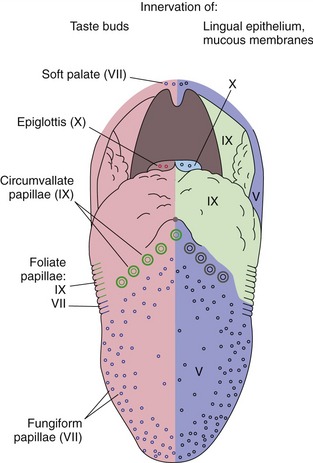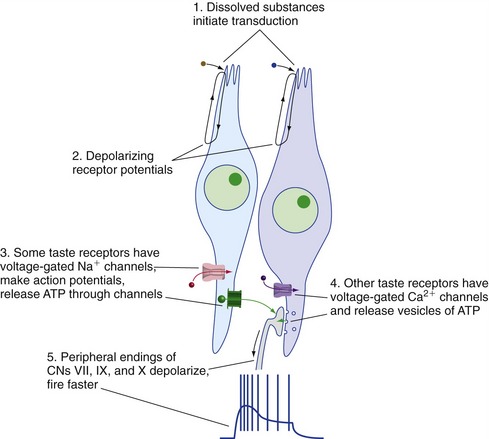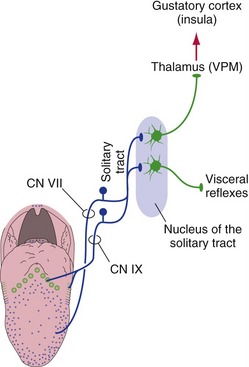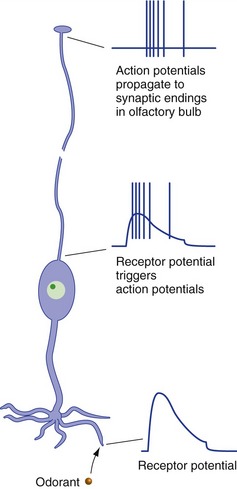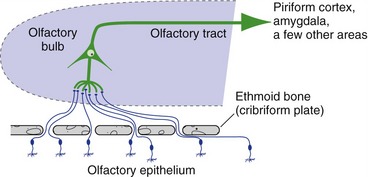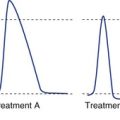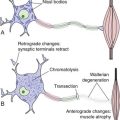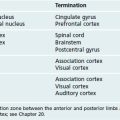13 The Chemical Senses of Taste and Smell
Taste Is Mediated by Receptors in Taste Buds, Innervated by Cranial Nerves VII, IX, and X
Circumvallate and most foliate papillae are innervated by the glossopharyngeal nerve (IX), fungiform and anterior foliate papillae by the facial nerve (VII). The vagus gets into the act by innervating the few taste buds farther back in the pharynx (probably more important for things like coughing when something nasty gets back there than for the perception of taste). This innervation is distinct from that taking care of touch, pain, and temperature in the mouth (Fig. 13-1).
Taste Receptor Cells Are Modified Epithelial Cells with Neuron-like Properties
Taste receptor cells, unlike most other receptors, are not neurons but rather are modified epithelial cells. Nevertheless, they have some very neuron-like properties: they make depolarizing receptor potentials (and many even make action potentials), which in turn increase the release of neurotransmitter (in this case, the principal transmitter is ATP) onto the peripheral processes of cranial nerve fibers (Fig. 13-2). Some taste receptor cells release ATP at typical chemical synapses. Others use an unusual Ca2+-independent mechanism in which big voltage-gated channels open and intracellular ATP just spills out into extracellular space.
Second-Order Gustatory Neurons Are Located in the Nucleus of the Solitary Tract
Afferents that innervate taste buds reach the brainstem with the facial nerve (from the anterior two thirds of the tongue), the glossopharyngeal nerve (from the posterior third of the tongue), and the vagus nerve (from the epiglottis and esophagus). Like other visceral afferents (see Fig. 12-10) they too travel within the brainstem in the solitary tract and end in the nucleus of the solitary tract, mostly in more rostral portions (Fig. 13-3).
Information about Taste Is Coded, in Part, by the Pattern of Activity in Populations of Neurons
We usually think of sensory receptors as being good at signaling the location of a stimulus, but this doesn’t work for taste buds. When we eat or drink, dissolved chemicals and vapors get distributed widely in the mouth and nose, so the stimulated taste buds and olfactory receptors can’t provide accurate information about the location of the stimulus; we use somatosensory cues instead to decide this. The major task of the gustatory and olfactory systems is to analyze the composition of mixtures of potentially thousands of chemicals. In principle, we could do this by having one kind of taste receptor specifically tuned to the taste of radishes, another to rutabagas, etc., but this would require an unwieldy number of receptor types. So instead we compare the levels of activity in populations of receptors, each population responsive to more than one kind of chemical. This is a lot like comparing the levels of activity in just three kinds of cones (see Chapter 17) to identify hundreds of colors.
Olfaction Is Mediated by Receptors That Project Directly to the Telencephalon
The olfactory pathway begins with bipolar receptor cells whose chemosensitive processes project into the layer of mucus covering the olfactory epithelium. These are long receptors, and the same receptor cells have thin axons (Fig. 13-4) that pass through the ethmoid bone as the olfactory nerve (CN I) and end in the olfactory bulb. Olfactory receptors are therefore highly unusual in having processes exposed to the outside world and in having axons that project directly to the telencephalon. They are also unusual in being neurons that are continuously replaced throughout life.
Olfactory Receptor Neurons Utilize a Large Number of G Protein–Coupled Receptors to Detect a Wide Range of Odors
Olfactory Information Bypasses the Thalamus on Its Way to the Cerebral Cortex
The olfactory system continues to break the rules by projecting to cerebral cortex without first relaying in the thalamus (Fig. 13-5). The fibers of the olfactory tract, which arises in the olfactory bulb, end in anterior temporal cortex (piriform cortex and nearby areas), as well as in the amygdala and in areas at the base of the brain (anterior perforated substance). Piriform and nearby cortex, however, is not neocortex like the cortex that covers most of the cerebral hemispheres (see Chapter 22); it has a simpler structure and is referred to as paleocortex. There is an additional olfactory area in neocortex, in the orbital cortex of the frontal lobe, where olfactory information converges with projections from gustatory cortex. In this case the rules are followed more closely: Information from piriform cortex reaches the orbital olfactory/gustatory area via a relay in the dorsomedial nucleus of the thalamus (as well as via direct projections). As in the case of gustatory pathways, all of these olfactory connections are mostly uncrossed.

